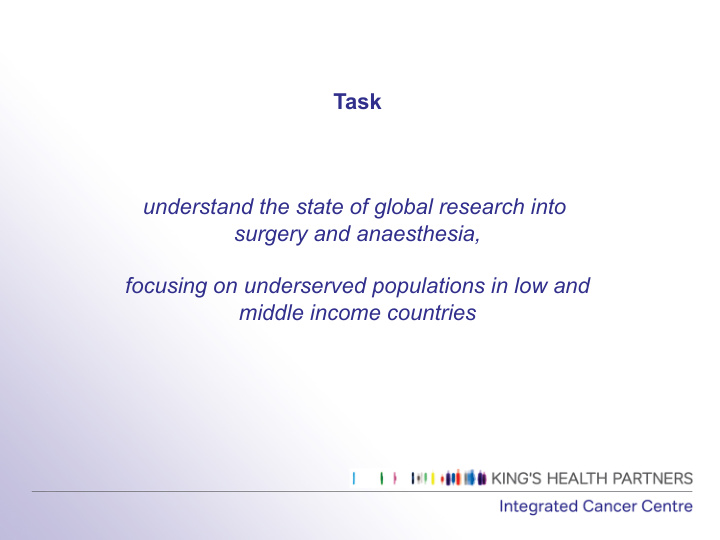



Task understand the state of global research into surgery and anaesthesia, focusing on underserved populations in low and middle income countries
Does research matter for surgery / anaesthesia? At the cutting edge of impossible . Te x Heart Inst J , 2009, 36:453.
Surgeons & anaesthetists as general research leaders % of faculty co-authoring general research papers 1 50 45 40 35 30 25 20 15 10 5 0 1995-1999 2000-2004 2005-2009 1. Onomastic linkage study: USA (ACS et al); UK (Royal Colleges); WACS; France.
Rest of talk will focus on research into the science and technology of surgery and anaesthesia The Public Policy Challenge
Who does surgery research? 35 countries account for 97.2% of all published research activity in surgery SURG frac count But surgery research only accounts for 4.1% of global health research activity Scientometric analysis creation of algorithms (>230) & analysis of various Db of publications: WoS, PUBMED etc. Variety of analytical tools to study research activity
Contributions to global surgical research in last 5 years (%) 8 middle inc ome countries contribute only 16.8% of surgical research output Only 4.3% of research outputs specifically ‘relevant’ to underserved populations
Whose surgical research ‘matters’? Surgical research is dominated by high income countries conducting high income research
Active surgical clinical trials (2013, with annual growth rates ) Data: WHO / ClinicalTrails.gov / India Reg / FR and UK CT registries
In comparison to medicines, surgery accounted for only 2.4% to 3.1% of total clinical trials activity between 2008-2012 1 High income countries account for 81% of activity, middle income 17% and low income (non-fragile) 2% Preliminary analysis shows over 73% of surgical clinical trials were only relevant to high income settings 1. Data reverse engineered frm USA Clinical Trials.gov NEJM 2015, 372;11: 1031-42 & UK’s UKCRC Db
So why has it come to this? Less research active surgeons Less global research into surgery and anesthesia What research is undertaken is mostly focused on need of high income countries
Dominance of biomedical culture Purushotham A & Sullivan R. Darwin, medicine and cancer. Annals Oncol 2010, 21: 199-203
Money matters: what are we investing in surgical research? In 2004/5 only 0.6% was surgery by 2009/10 dropped to 0.3% of a total annual budget of 12.35 billion USD 1 Less than 2M USD funding surgical research in underserved populations 1. Analysis of USA (NIH) and UK (CRC) public funding Db
Culture of surgery as a barrier - Smaller, single institution research - 68% less international collaboration - 45% less national collaboration - Low levels of research organisation in MIC and almost non in LIC Group psychology cohort study on-going: personalities in surgery and medicine: a question of nature or nurture?
Pulling s surgica cal r research ch b back ck from t the b brink…. “Pharmacogenetics is dead and warfarin killed it” ”
The Commission has identified a plethora of key areas for research INDICATORS Preparedness for surgical and anesthesia care • Access to timely surgery • Specialist surgical workforce density Delivery of surgical and anesthesia care • Surgical volume • Perioperative mortality Effect of surgical and anesthesia care • Protection against impoverishing expenditure • Protection against catastrophic expenditure
Solving the surgical research crisis with some radical creativity 1. Building research training in LMIC 2. Research core funding as part of capacity building from outset 3. Radical improvement in HIC & some MIC research funders approach to investing in surgical research e.g. NATO, DoD, MoD & trauma surgical research in low resource settings
Recommend
More recommend